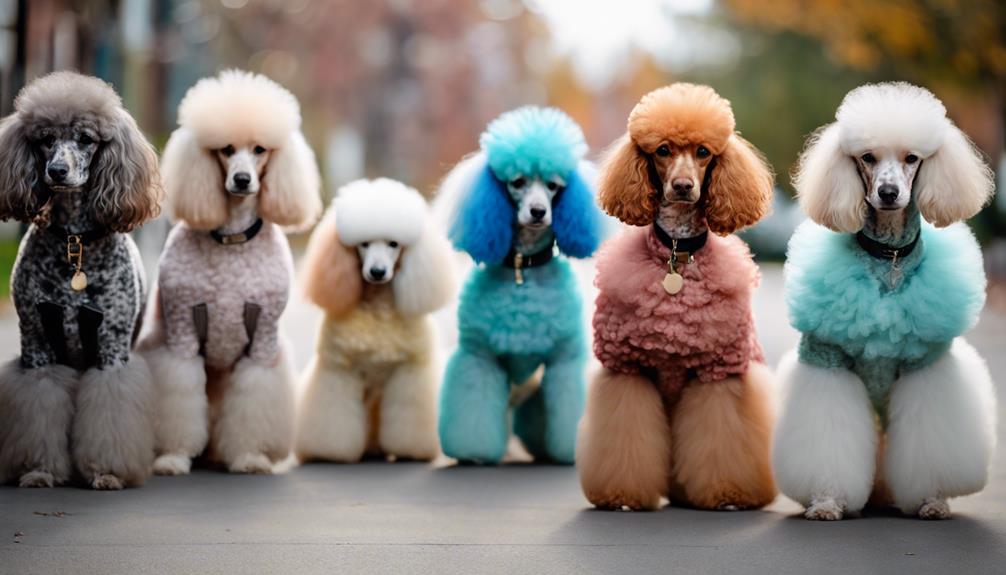You might think that poodles only come in standard solid colors, but you'd be surprised by the array of unique coat variations that exist within this beloved breed. From the striking patterns of Parti and Brindle Poodles to the mesmerizing hues of Merle and Sable coats, the world of unconventional poodle coats is truly captivating. As you explore further, you'll uncover the secrets behind these extraordinary coat colors and patterns, shedding light on the fascinating diversity that sets these poodles apart from the rest.
Key Takeaways
- Poodle coats exhibit diverse variations from sable and abstract to tuxedo and harlequin patterns.
- Understanding genetics is crucial for breeding unique coat colors and maintaining breed standards.
- Tailoring grooming routines is essential to preserve the integrity of different coat textures and colors.
- Special considerations like merle gene health risks and sun protection are vital for Merle Poodles.
Sable Poodles
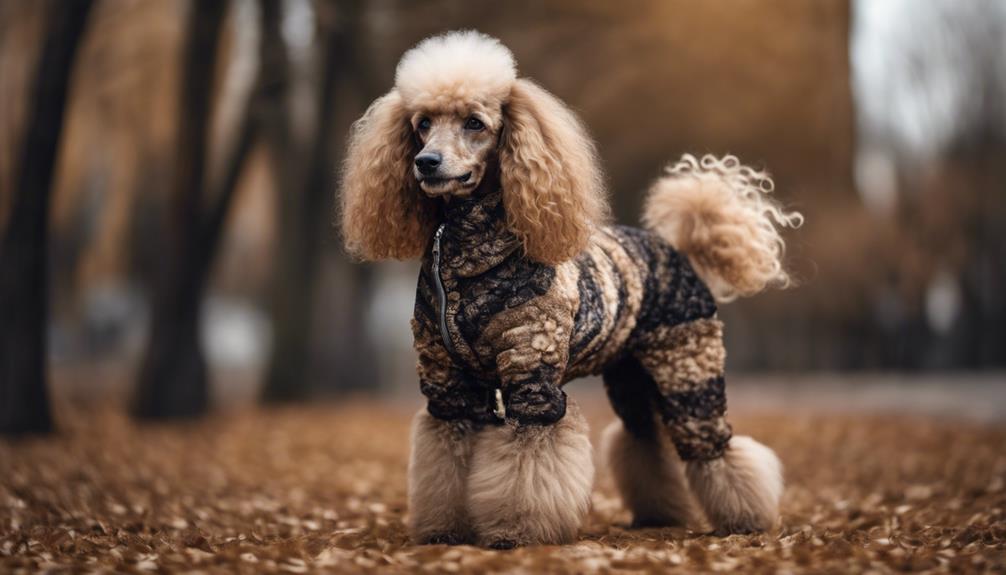
Sable Poodles exhibit a unique coat pattern characterized by dark-tipped hairs that create a striking gradient effect. This coat variation is highly sought after for its distinctive appearance. The dark tips on a Sable Poodle's coat can vary from a deep black to a rich brown color, providing a range of shades that add depth and dimension to their overall look. The gradient effect produced by these dark-tipped hairs gives Sable Poodles a visually appealing and unique aesthetic.
This coat variation sets Sable Poodles apart from other color variations within the breed. The contrast between the darker tips and the lighter base color enhances the beauty of these Poodles, making them stand out in a crowd. Breeders and owners appreciate the intricate beauty of the Sable coat pattern, which adds an element of elegance to the Poodle's appearance. Understanding the nuances of coat variations like Sable in Poodles can aid in appreciating the breed's diversity and beauty.
Abstract Poodles
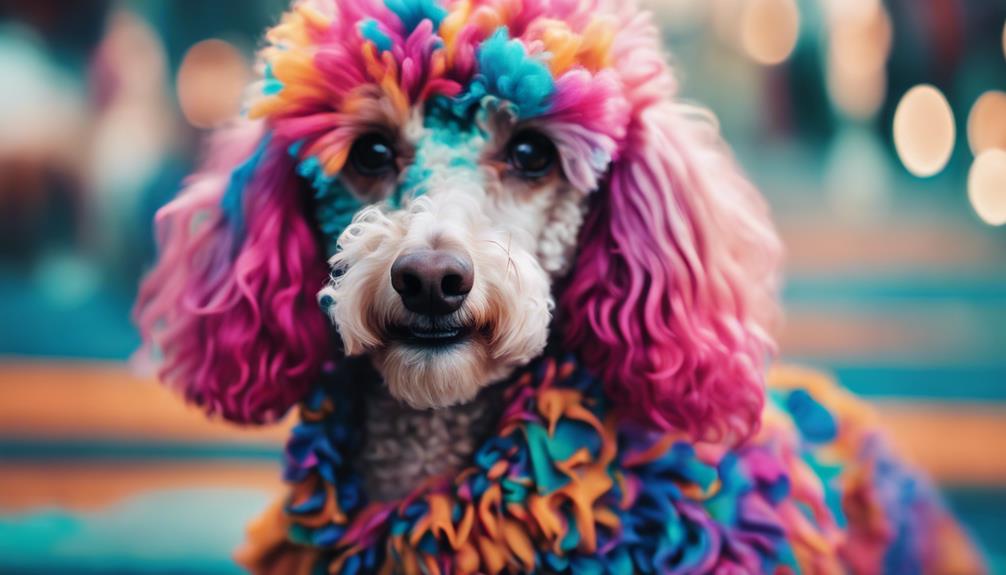
Abstract Poodles exhibit rare coat colors, with intricate and unusual patterns that captivate the eye. The texture variations in their coats add depth to their already unique appearance. This combination of elements results in a visually stunning and artistically inspired canine coat.
Rare Coat Colors
Rare coat colors in poodles, particularly the Abstract variety, exhibit a unique range of unconventional hues and patterns that diverge from the standard poodle color palette.
- Abstract Poodles display a diverse array of coat colors that include marbled, speckled, or mottled patterns.
- These unique patterns and individualistic designs contribute to the visual appeal of Abstract Poodles.
- Breeders and enthusiasts highly value the distinctive coat designs of Abstract Poodles for their creativity and deviation from traditional norms.
- The unconventional coat colors in Abstract Poodles serve as an artistic expression, attracting admiration and attention from those who appreciate the breed's creativity.
Unusual Coat Patterns
Unconventional coat patterns found in Abstract Poodles exhibit a wide range of artistic designs that diverge from traditional solid colors. Abstract Poodles can showcase a variety of patterns such as swirls, speckles, patches, and other unique designs. Breeders play a crucial role in selectively breeding for these unusual coat patterns, aiming to create visually stunning and individualistic Poodles. These abstract coat patterns, characterized by a mix of colors, contribute to the Poodle's striking appearance, making them stand out in competitions and capturing attention for their distinct looks.
| Unusual Coat Patterns | Description |
|---|---|
| Swirls | Twisting patterns on the coat |
| Speckles | Scattered spots of color |
| Patches | Distinct sections of color |
Coat Texture Variations
Coat texture variations in Poodles with unique abstract patterns encompass a diverse range of curly, wavy, and straight textures that significantly contribute to the breed's distinct appearance and grooming requirements. Understanding these different types is essential for providing the extra care needed to maintain their coat health and prevent potential health issues. Here are some key points to consider:
- Curly coats: Dense and tightly wound, requiring regular grooming to prevent matting.
- Wavy coats: Softer appearance with a looser wave pattern, necessitating proper grooming care.
- Straight coats: Less common, featuring sleek, flat hair that may need specialized grooming techniques.
- Tailoring grooming routines and products according to the specific coat texture is crucial for ensuring the overall health and aesthetics of Abstract Poodles.
Tuxedo Poodles
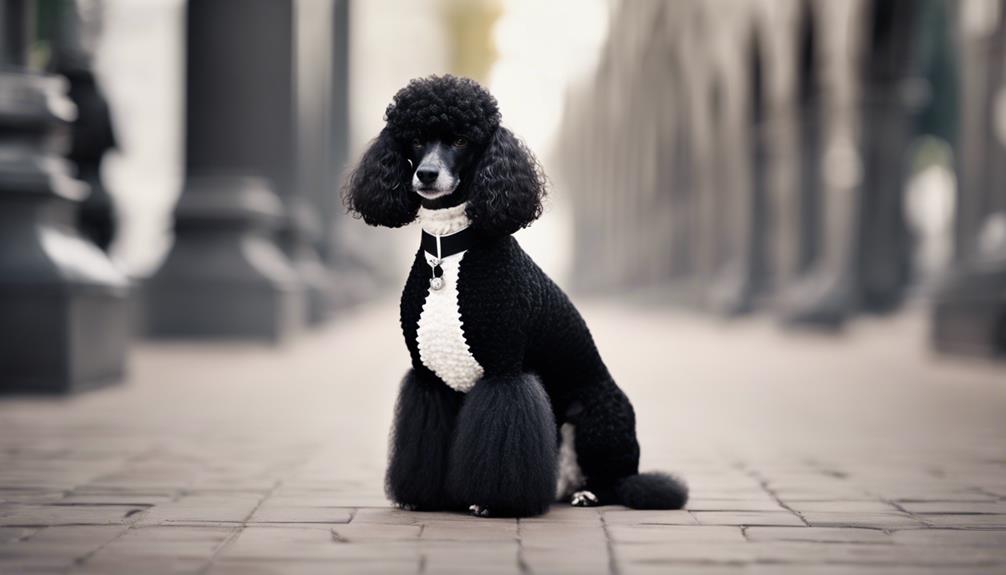
Tuxedo Poodles exhibit a unique coat pattern characterized by a blend of cream, beige, black, red, and white hues, reminiscent of a formal tuxedo ensemble. The distinct coat distribution typically features a solid base color complemented by contrasting patches or markings, mirroring the design of a traditional tuxedo. Understanding the genetics behind Tuxedo Poodle coat variations, implementing proper grooming techniques, and recognizing their distinctive temperament are key aspects to consider when delving into the fascinating world of Tuxedo Poodles.
Tuxedo Poodle Genetics
In the breeding of Poodles, the genetic basis for the striking tuxedo coat pattern lies in the inheritance of specific color alleles.
- Tuxedo Poodles exhibit a unique coat pattern with a combination of cream, beige, black, red, and white colors.
- The tuxedo pattern typically showcases a solid color on the body with white markings on the chest, legs, and sometimes the face, resembling formal wear.
- Breeders select for the tuxedo coat pattern to create Poodles with eye-catching color combinations that appeal to enthusiasts and potential owners.
- This sought-after trait adds a touch of elegance and style to the breed's overall aesthetic appeal, making Tuxedo Poodles stand out among other coat variations.
Grooming Tuxedo Poodles
To properly groom a Tuxedo Poodle, focus on maintaining the distinct color division between the darker and lighter hues of its coat, ensuring a sharp and elegant appearance reminiscent of a formal tuxedo. When bathing your Tuxedo Poodle, opt for cold water as hot water can strip its coat of natural oils. Use gentle shampoos specifically formulated for dogs to avoid irritation, as Tuxedo Poodles may be more sensitive to harsh chemicals due to their unique coat composition. Brush your Tuxedo Poodle regularly to prevent matting and tangling, using a wide range of grooming tools suitable for different coat textures. By following these grooming practices, you can help your Tuxedo Poodle maintain its distinctive tuxedo-like appearance and keep its coat healthy and lustrous.
Tuxedo Poodle Temperament
With what frequency do Tuxedo Poodles exhibit their distinctive coat pattern in comparison to other Poodle variations?
- Tuxedo Poodles are relatively rare amongst Poodle variations, making up a small percentage of the overall Poodle population.
- The unique coat pattern of Tuxedo Poodles is highly desirable amongst owners seeking a visually striking companion.
- Despite their eye-catching appearance, Tuxedo Poodles maintain the standard Poodle temperament traits of intelligence, trainability, and social nature.
- It is important to avoid breeding practices solely focused on coat color, as this can lead to health issues and compromise the overall well-being of the Tuxedo Poodle.
Rare Coat Poodles
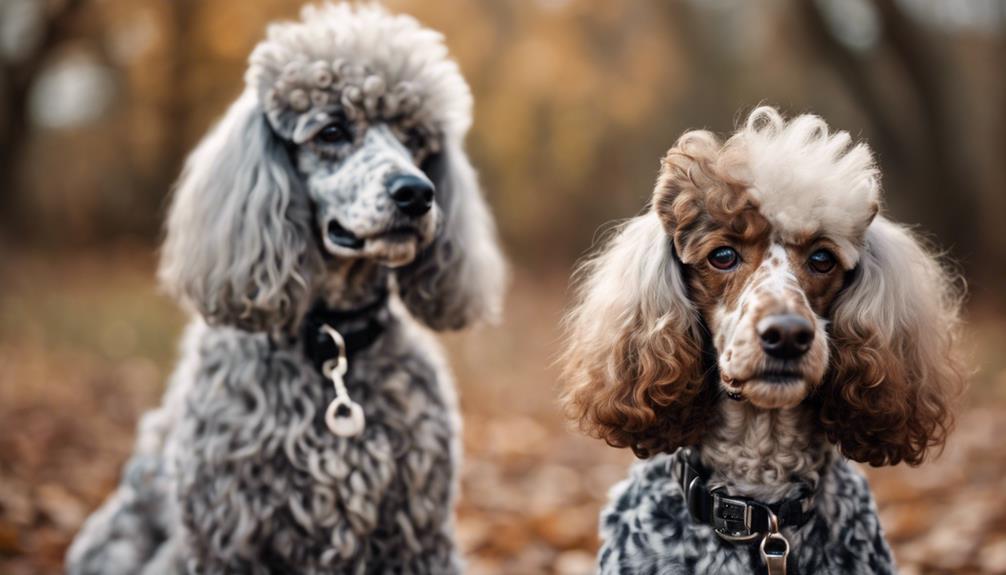
Rare coat poodles exhibit distinctive patterns such as brindle, sable, merle, harlequin, tuxedo, and tri-color variations, making them stand out among their counterparts. Achieving these rare coat colors involves a deep understanding of coat color genetics, rare coat breeding techniques, and precise coat pattern selection. Breeders carefully select genes to produce these unique patterns while ensuring they align with breed standards. The process of breeding for rare coat colors requires attention to detail to maintain the overall health and well-being of the poodle.
While rare coat poodles can be visually striking and captivating, it is essential to note that certain variations, such as merle poodles, may present potential health concerns due to the genetic factors involved. Therefore, prospective poodle owners interested in rare coat variations should work closely with reputable breeders who prioritize the health and welfare of their dogs. Despite the challenges, rare coat poodles offer a distinctive choice for those seeking a companion with a truly exceptional appearance.
Merle Poodles
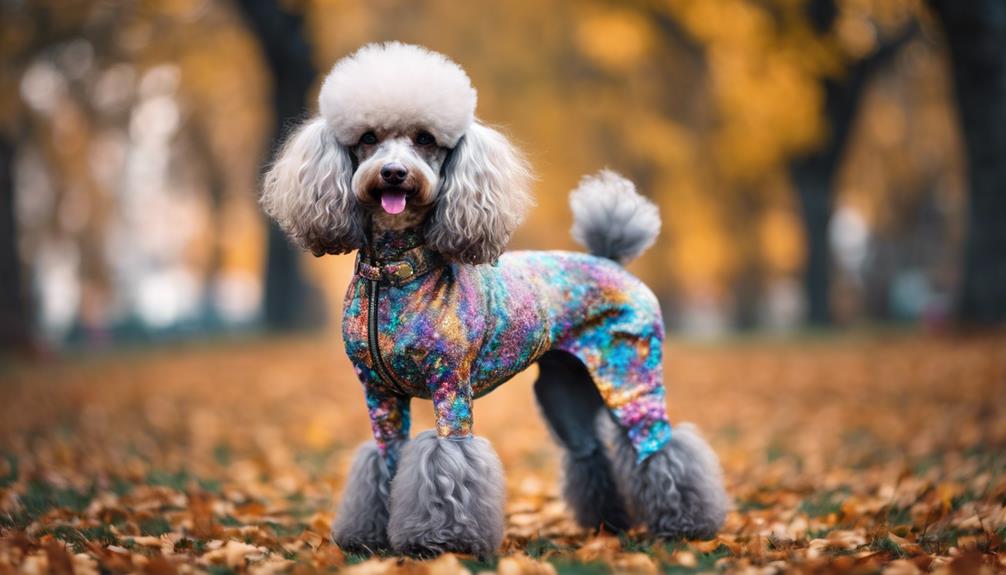
Merle Poodles exhibit a unique coat pattern characterized by diluted color patches, typically in shades like blue, gray, and tan. The merle gene responsible for this distinctive pattern can result in a variety of coat color variations, creating visually appealing effects. However, it's crucial to note that breeding merle Poodles requires careful consideration due to potential health issues associated with the merle gene, such as deafness, eye abnormalities, and skin problems.
Merle Poodle Genetics
In Poodle genetics, the merle coat pattern presents a distinct and unique color variation that requires careful breeding considerations to maintain the health and standards of the breed.
- Merle Poodle Inheritance: Understanding the genetic basis of the merle pattern is crucial for responsible breeding practices and avoiding potential health issues.
- Merle Poodle Health Risks: The merle gene can lead to deafness and blindness, making it essential for breeders to prioritize the health of the puppies.
- Merle Poodle Breeding Ethics: Breeding two merle Poodles can result in genetic abnormalities, highlighting the importance of ethical breeding practices.
- Genetic Testing: Prioritize genetic testing to identify merle carriers and ensure healthier breeding practices for the well-being of the Poodle breed.
Coat Color Variations
Understanding the intricacies of coat color variations in Poodles, particularly the unique patterns like merle, is essential for breeders to maintain the health and standards of the breed. Merle Poodles showcase a rare coat pattern distinguished by diluted color patches, creating a visually striking aesthetic. This distinct coat color pattern is a result of a genetic mutation that alters the distribution of pigment, leading to characteristic patches or spots. While not recognized in standard Poodle breed standards, merle Poodles are highly sought after for their unique appearance. However, breeders must exercise caution when breeding merle Poodles due to the potential health risks associated with the merle gene, which can manifest as deafness or eye abnormalities. Prioritizing the well-being of the dogs is paramount when selecting for coat color diversity in breeding programs.
Health Considerations
Considerations for the health of Poodles with the merle coat pattern include potential risks associated with the genetic trait. Merle poodles, due to the merle gene, can face health risks such as deafness, blindness, and eye abnormalities. To safeguard the well-being of merle-patterned dogs, responsible breeding practices emphasize genetic testing and meticulous selection processes. Additionally, the lighter pigmentation in their coat makes merle poodles susceptible to sun sensitivity, necessitating sun protection measures to prevent skin damage. It is imperative for prospective merle poodle owners to educate themselves about the genetic implications and health considerations linked to this distinct coat pattern.
- Genetic testing plays a crucial role in identifying potential health issues in merle poodles.
- Health risks associated with the merle gene include deafness, blindness, and eye abnormalities.
- Responsible breeding practices aim to mitigate health concerns related to the merle coat pattern.
- Sun protection is essential to shield merle poodles from sun sensitivity and potential skin damage.
Harlequin Poodles
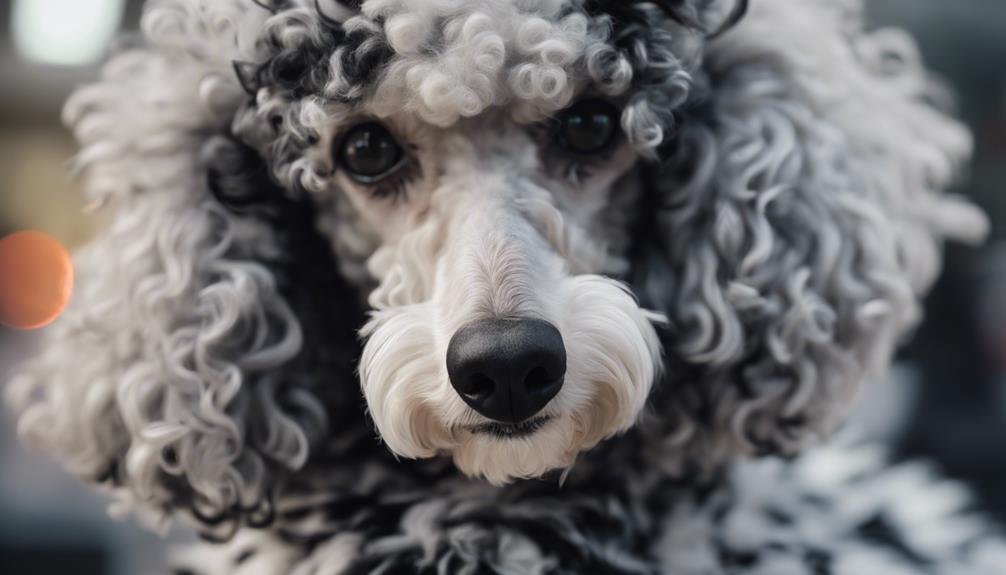
With a distinctive coat pattern characterized by a white base color adorned with irregular black spots or patches, Harlequin Poodles stand out as a rare and unique variation among the breed. The origins of the Harlequin Poodle coat pattern can be traced back to specific genetic combinations that result in this striking look. As Harlequin Poodles mature, the black spots on their coat tend to increase in size and intensity, creating a visually appealing contrast against the white base. Due to their non-standard coat pattern, Harlequin Poodles may not be eligible for traditional dog shows. However, they are highly sought after by enthusiasts who appreciate their unique appearance. When it comes to care tips, Harlequin Poodles require regular grooming to maintain the beauty of their coat and prevent matting. Training techniques for Harlequin Poodles should focus on positive reinforcement methods to ensure their socialization and obedience skills develop effectively.
Parti Poodles
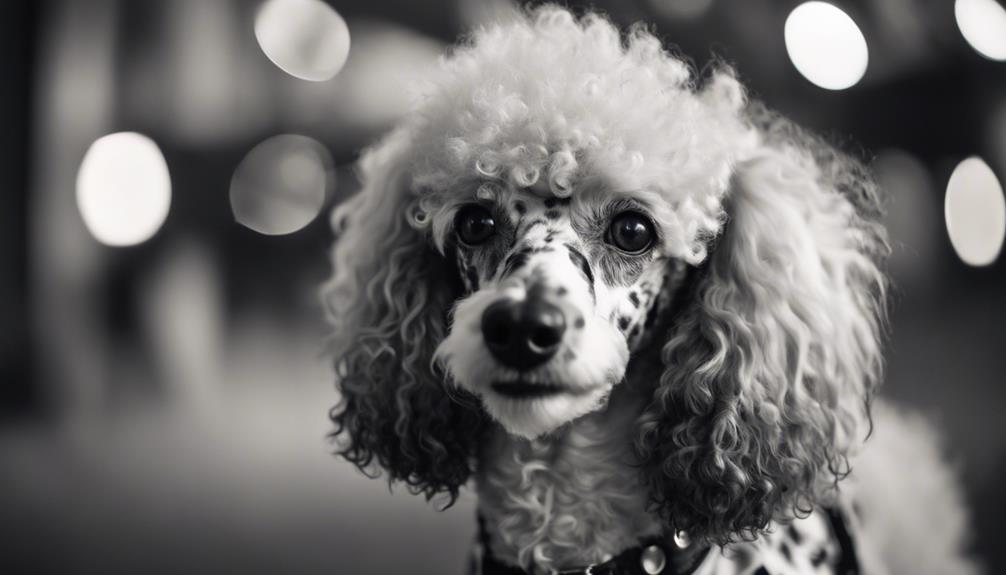
Parti Poodles exhibit a distinctive coat pattern characterized by a white base color with patches of another hue, such as black, brown, or red. Breeders meticulously select and breed Parti Poodles to enhance and maintain these unique color combinations. The American Kennel Club recognizes Parti Poodles as a separate color variation, with specific criteria ensuring the authenticity of their striking coat patterns.
Parti Poodle Patterns
A unique coat pattern found in Poodles, the Parti Poodle showcases distinctive characteristics with at least 50% white fur and patches of another color like brown or black.
- Coat Color Genetics: Parti Poodle patterns are a result of specific genes interacting to produce the desired color distribution.
- Parti Poodle Popularity: Despite historical biases, Parti Poodles have gained popularity for their unique and eye-catching coats.
- Coat Pattern Inheritance: The inheritance of Parti Poodle coat patterns follows genetic principles, allowing breeders to predict and selectively breed for desired patterns.
- Individual Variation: Each Parti Poodle's coat pattern is unique, with variations in the distribution and intensity of colors, adding to their charm and individuality.
Breeding Parti Poodles
Breeding Parti Poodles involves selecting specific color genes to achieve the desired coat pattern and distribution, ensuring the continuation of unique and eye-catching traits within the breed. Color genetics play a crucial role in determining the percentage of white base color and the distribution of patches in Parti Poodles. Breeders meticulously study coat pattern selection to enhance visual appeal in breeding programs, aiming to produce striking variations in color combinations. By focusing on maintaining breed standards while emphasizing distinctive coat patterns, breeders contribute to the popularity of Parti Poodles within the dog breeding community. The intricate process of breeding Parti Poodles requires a deep understanding of genetics to create visually appealing and genetically sound offspring that uphold the charm and allure of this unique Poodle variety.
Phantom Poodles
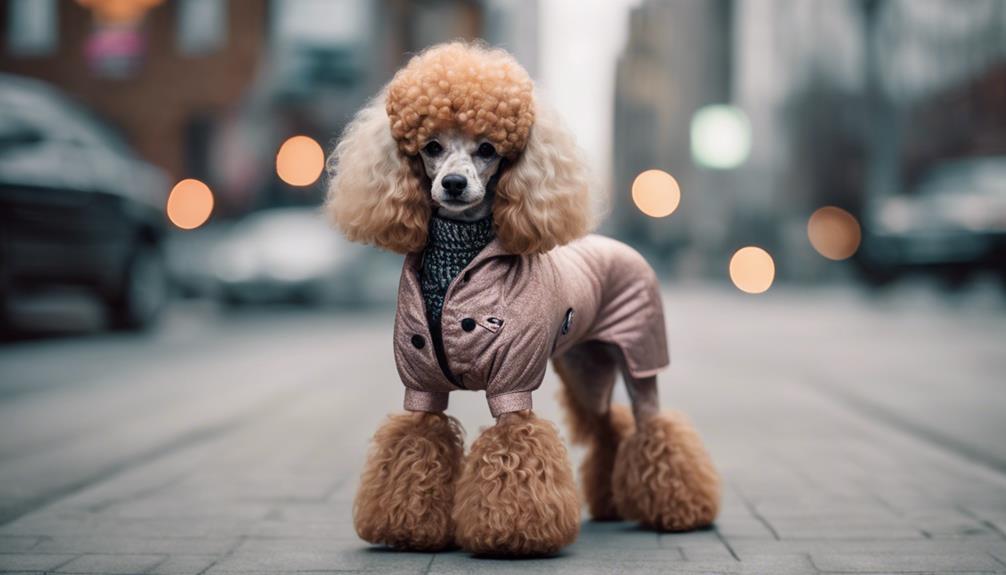
Phantom poodles exhibit distinctive coat markings showcasing specific colors on defined areas of their body, including the face, legs, chest, and under the tail.
- Coat Coloration: The phantom pattern consists of two colors with specific placements, such as tan or rust markings on a black, brown, or red base coat.
- Breeding Considerations: Breeders carefully select for the phantom pattern through genetic testing to produce poodles with consistent and desirable coat markings.
- Show Ring Standards: This unique coat pattern is recognized and admired in the poodle breed standard, adding to the variety of coat colors available.
- Coat Maintenance: Phantom poodles can have varying degrees of contrast between the main coat color and the markings, creating a striking and eye-catching appearance.
When caring for a phantom poodle, it is crucial to consider their coat coloration, adhere to breeding standards, and ensure proper grooming techniques to maintain their exquisite appearance. By understanding the genetic aspects and show ring standards associated with phantom poodles, you can appreciate the beauty and complexity of this unique coat pattern.
Brindle Poodles
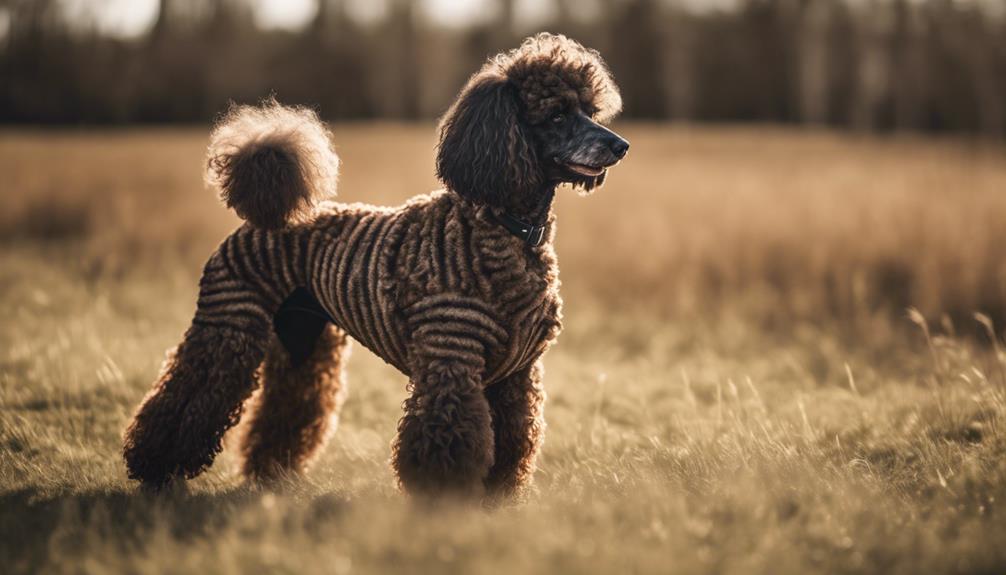
Exhibiting a unique coat pattern characterized by visible black stripes over a lighter base color, brindle poodles present a striking and distinctive appearance. The brindle pattern remains bold even when the coat is shaved, emphasizing the contrast between the stripes and the base color. This less common yet highly sought-after variation among Poodle enthusiasts offers an individualistic look that stands out. Brindle Poodles can display varying shades and intensities of black striping, enhancing their overall appearance with depth and character. The genetic combinations responsible for the brindle coat pattern showcase the fascinating diversity of coat colors found in Poodles.
| Aspect | Description |
|---|---|
| Brindle Poodle Care | Regular grooming to maintain the coat's luster and health is essential. |
| Brindle Poodle Grooming | Brushing at least twice a week to prevent matting and remove loose fur. |
| Brindle Poodle Training | Positive reinforcement techniques work best due to their intelligent nature. |
For those caring for brindle Poodles, diligence in grooming, training, and care routines is key to ensuring these unique canines thrive and maintain their distinctive appearance.
Tri-Color Poodles
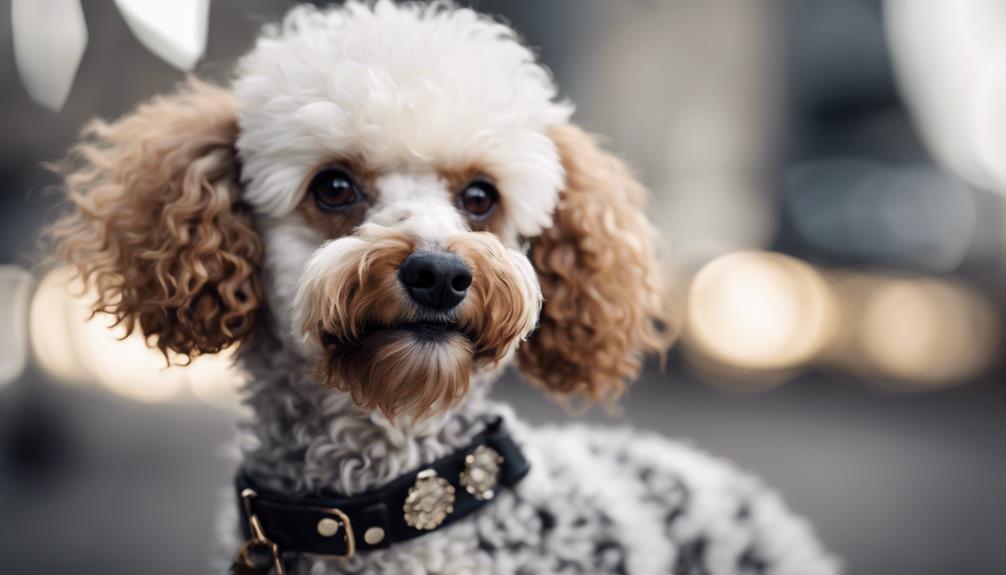
Tri-Color Poodles showcase a captivating coat pattern characterized by the harmonious combination of three distinct colors, often including white, black, and a third color like tan or brown.
- Coat color genetics: The unique tri-color pattern in Poodles is a result of complex genetic interactions involving multiple genes responsible for coat color.
- Coat pattern inheritance: Tri-color coat patterns can be inherited from parent Poodles with similar color variations, but the expression of these patterns can vary among offspring due to genetic recombination.
- Coat color standards: While tri-color Poodles may not always conform to the strict color standards set by breed organizations for show competitions, they are highly sought after for their aesthetic appeal and unique appearance.
- Distinctive appearance: Tri-color Poodles stand out for their exceptional and eye-catching coat coloration, making them a favorite choice for those looking for a Poodle with a striking and memorable appearance.
Solid Color Poodles
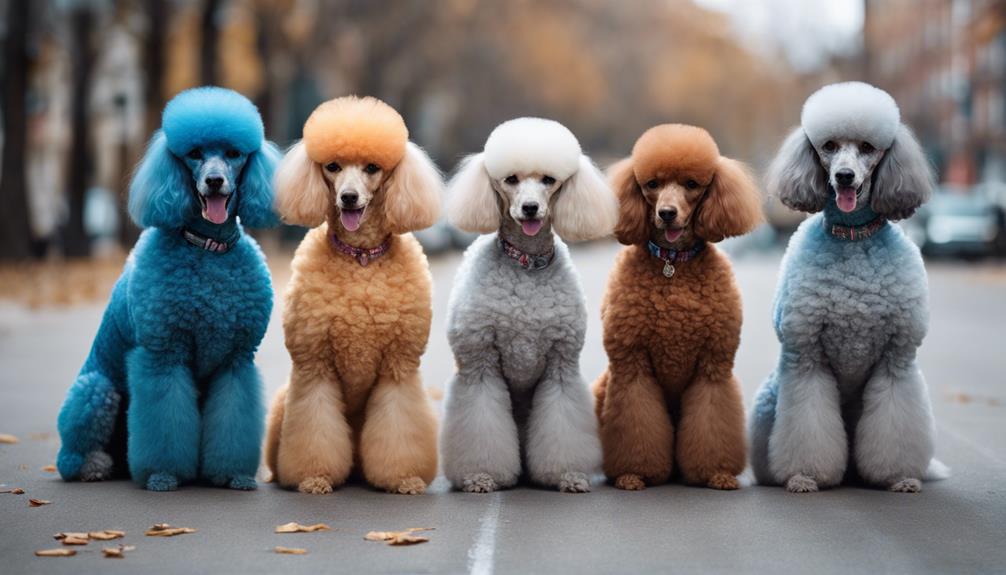
Solid color Poodles present the most prevalent coat variations within the breed, encompassing shades like black, white, red, and silver. These colors align with the American Kennel Club (AKC) standards for poodle coat colors in competitions. Solid color Poodles are highly valued for their refined and stylish appearance, reflecting the breed's elegance. Black solid color Poodles exhibit a consistent and lustrous black coat that maintains its richness over time, meeting the breed standard. Their uniform color provides a sleek and sophisticated look, showcasing the poodle's versatile coat qualities.
When it comes to coat care, solid color Poodles require regular maintenance to preserve the richness of their color and the health of their coat. This includes regular grooming, bathing with suitable products for their specific coat type, and brushing to prevent matting and tangling. Monitoring coat health is crucial to detect any issues early, such as dryness, excessive shedding, or skin irritations. By following a consistent coat care routine, solid color Poodle owners can ensure their pet's coat remains vibrant and healthy.
Multi-Colored Poodles
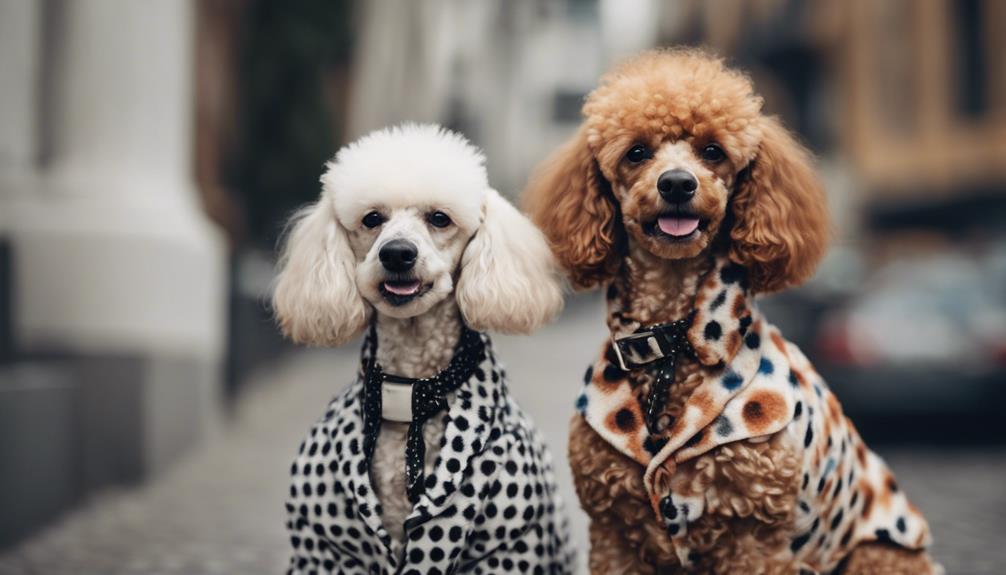
Featuring a unique coat pattern with a predominant white base color complemented by patches of other hues such as black, brown, or red, Multi-Colored Poodles, like Parti Poodles, present a visually striking and vibrant appearance.
- Coat Care and Grooming Techniques: The multi-colored coat of Parti Poodles requires regular grooming to prevent matting and maintain its beauty. Brushing their coat a few times a week and regular visits to a professional groomer are essential to keep their fur in top condition.
- Coat Color Genetics: The genetics behind the multi-colored coats in Parti Poodles involve specific combinations of genes that determine the distribution of colors. Understanding these genetic factors can help breeders predict the coat colors of future litters.
- Personality Traits and Behavior Tendencies: Parti Poodles are known for their charming and playful personalities. They are friendly, intelligent, and affectionate, making them excellent companions for families seeking an energetic and loving pet.
- Unique Appearance: The striking and varied look of multi-colored Poodles, with their patches of contrasting colors against a white base, sets them apart from other poodle varieties, making them highly sought after for their distinctive appearance.
Unique Poodle Coats
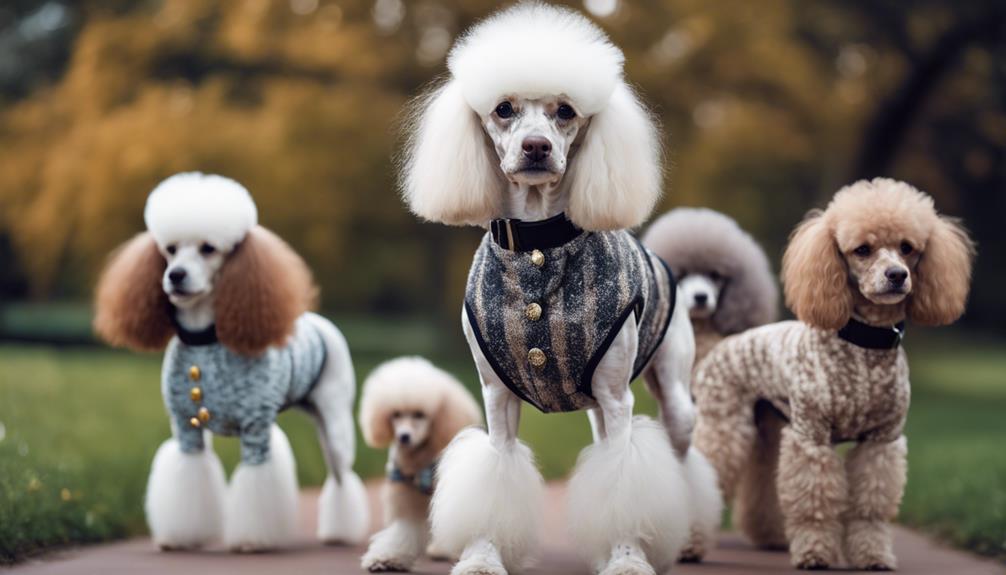
Diverse patterns and color variations in Poodle coats result from a combination of specific genetic markers influencing pigmentation distribution. Coat color genetics play a crucial role in the unique coat patterns seen in Poodles. The evolution of these coat patterns has been shaped by intricate genetic mechanisms that dictate how colors and patterns manifest in the breed. Understanding these genetic factors can provide insights into the fascinating array of coat variations found in Poodles.
When caring for Poodles with unique coats, it is essential to consider their specific coat care needs. Different coat patterns may require tailored grooming routines to maintain their distinct appearance. Regular brushing and grooming can help preserve the integrity of the coat and prevent matting or tangling. Additionally, using appropriate grooming tools and products designed for your Poodle's coat type can contribute to keeping their coat healthy and vibrant. By understanding the genetic basis of coat colors and patterns, you can better care for Poodles with unique coats and appreciate the beauty of their diverse appearances.
Poodle Coat Variations
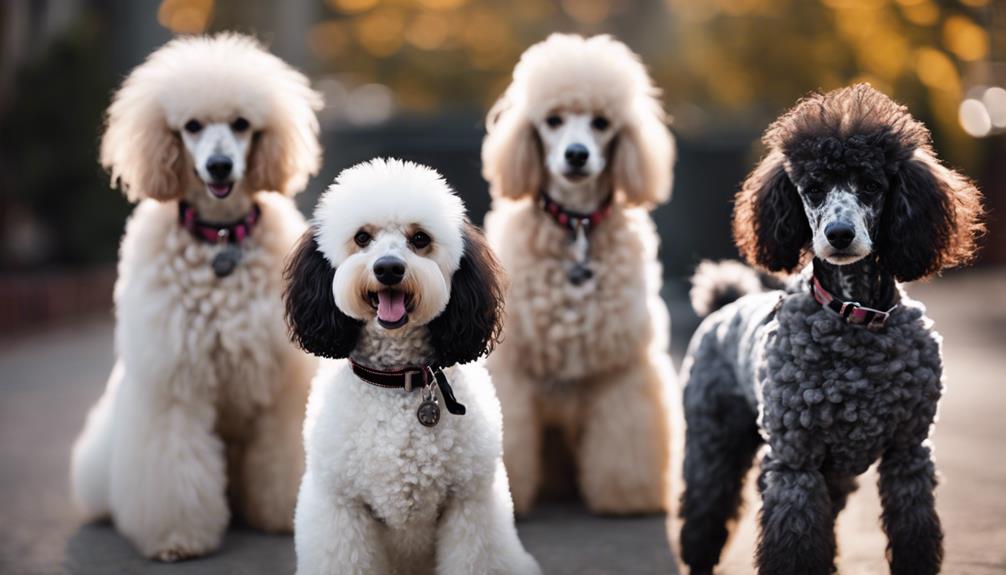
The intricate genetic mechanisms governing pigmentation distribution in Poodle coats contribute to the striking array of coat variations observed in different Poodle breeds. These variations include:
- Parti Poodles: These Poodles exhibit abstract patterns with at least 50% white fur and patches of another color like brown or black, creating a unique and eye-catching appearance.
- Sable Poodles: Known for their gradient effect, Sable Poodles have dark tips on their fur, giving them a luxurious appearance that is highly sought after.
- Brindle Poodles: Featuring prominent black stripes over a lighter base color, Brindle Poodles showcase a distinctive pattern that remains visible even when their coat is shaved.
- Merle Poodles: This rare variation displays diluted color patches, creating a marbled effect on the coat. However, it is important to note that Merle Poodles may be associated with certain health concerns due to the genetics of the coat pattern.
Understanding these coat variations not only adds to the aesthetic appeal of Poodles but also sheds light on the fascinating tuxedo genetics and abstract patterns that make each Poodle unique.
Poodle Coat Genetics
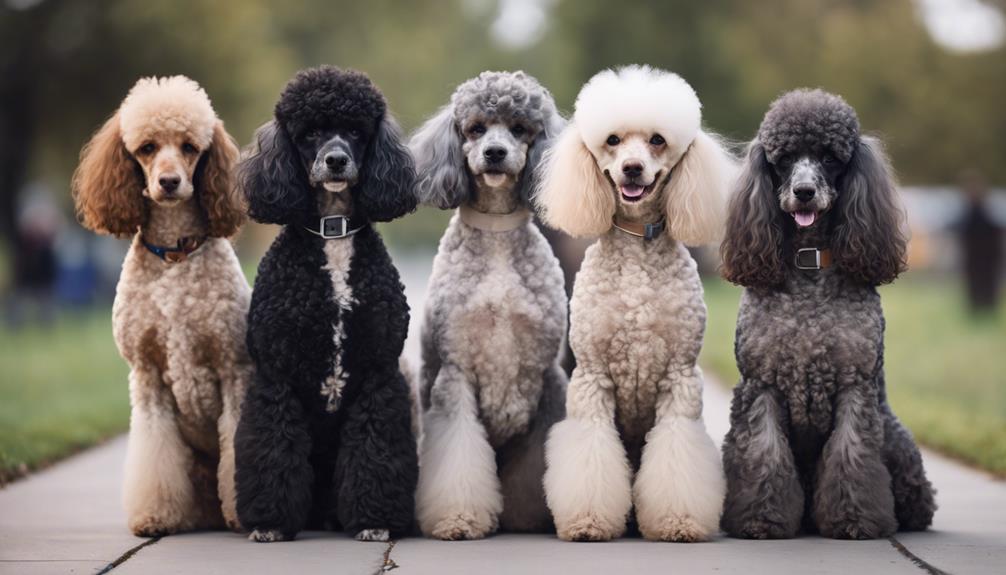
In the realm of Poodle genetics, the intricate interplay of multiple genes dictates the fascinating array of coat colors and patterns seen in these beloved canine companions. Poodle coat color inheritance is a complex process governed by genetic traits that control the production of pigments such as eumelanin (black/brown) and pheomelanin (red/yellow). Understanding the principles of Mendelian genetics is crucial, as dominant and recessive genes contribute to the inheritance of specific coat colors. Moreover, Poodles can carry hidden color genes, which may result in unexpected coat color variations in their offspring.
—
| Coat Color Inheritance | Genetic Traits | Hidden Color Genes |
|---|---|---|
| Controlled by multiple genes | Dictate pigment production | Lead to unexpected variations |
| Follows Mendelian genetics | Influence coat color inheritance | Present in Poodles |
| Involves dominant and recessive genes | Determine specific coat colors | Cause surprises in offspring |
Frequently Asked Questions
What Is the Rarest Color of Poodle?
The rarest color of Poodle is the Merle Poodle, known for its diluted color patches. Genetic mutations contribute to this unique coat. Proper breeding practices are vital for maintaining health. Enthusiasts seek out these distinctive patterns.
What Is Unique About the Poodle's Coat?
Your poodle's coat is a masterpiece of variety, boasting different textures and intricate patterns. Grooming it is an art form; regular maintenance keeps it luxurious. Embrace the uniqueness of your poodle's coat with proper care.
What Is Unusual About Poodles?
When it comes to Poodles, what makes them unique are their unusual coat patterns, genetic mutations that create rare colors like merle or brindle, and the diverse coat texture variations. These distinctive traits set Poodles apart.
What Does a Phantom Poodle Look Like?
When you see a Phantom Poodle, you'll be mesmerized by their stunning solid base coat with unique tan, apricot, or silver markings. Their appearance is a beautiful mix of elegance and charm. Grooming is crucial to maintain their distinctive look.
Conclusion
In conclusion, poodles with unusual coats offer a fascinating glimpse into the diverse world of canine genetics and aesthetics. With their unique colors and patterns, these poodles showcase the intricate complexities of coat variations and genetics. From Sable to Merle to Tuxedo coats, each poodle brings a touch of individuality and charm to the breed. But have you ever wondered how these rare coat patterns come to be?
